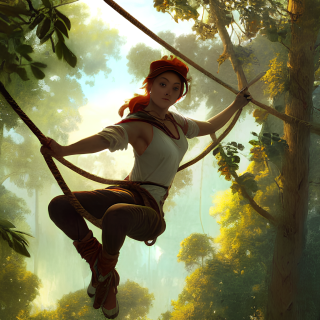Travel between settlements is all via foot, riding animal or carts, via various kinds of route:
Boardways
Boardways are routes through the trees which are boarded (or over large enough branches) to accommodate a cart - whether pulled by a person, or by a beast of burden. At their best they may be broad and flat (mounted on beams), easily wide enough for carts to pass in opposite directions, and well protected with rails at the edges. At their most basic they may be glorified rope bridges forming great arcs between the trees, where passing places are often sited. They may even lack any sort of guard rails or ropes, requiring great care to ensure draft animals are not spooked or disturbed if disaster is to be prevented. Boardways only link settlements of some significance, which then naturally form trade hubs as they are the only places between which any form of bulk shipment can take place. (See Trade and Money.) In normal conditions, travel along boardways is analogous to overland travel in terms of time taken and distance covered.
Ropeways
Ropeways are established routes with maintained infrastructure, but only intended for foot traffic, so at their most basic they might be only a single-stranded rope bridge with hand-ropes for stability - although they are often better protected than this. Clearly unsuitable for carts, goods can only be shipped along them via suitably trained beasts of burden (analogous to mule trains) or on the backs of the travellers themselves. Nevertheless, in normal conditions and in the absence of bulky loads, travel along ropeways is analogous to overland travel in terms of time taken and distance covered.
Wildways
A wildway is an established route, but not one that can simply be walked along - it may involve long climbs up or down trees, wide rope swings (using a fixed rope with cords to pull it to either side of a gap) or even single overhead ropes to be traversed hand-over-hand or suspended in a rope sling on a pulley. As wildways develop paired ziplines in opposite directions are sometimes set up to speed passage in busy areas, although this is often a precursor to an upgrade to a true ropeway. Goods can be carried only on the backs of travellers, or by specially trained ape-like beasts (see Icegrip Ape). Prices are higher in a village only accessible via wildways.
A fully-fit group, especially if it includes an Equika guide to manage ropes and assist heavier members of the party, can travel in good conditions at speed analogous to overland travel if lightly loaded. However the very young or very old or the injured can slow progress greatly, as can the need to carry bulky or heavy loads or to operate in poor conditions. Only the hardy travel the wildways in the depths of winter when ice forms on the ropes and gloved hands can easily become clumsy.
Earthways
Occasionally a route will need to descend to the ground for a (normally short) distance. This option is only accepted in extreme cases - perhaps because a section of forest that can’t easily be bypassed has burned down, or even deliberately been felled by a determined and destructive enemy. Earthways represent extreme risk due to the Gargantuan - but sometimes needs must, or sufficient potential profit provides the required incentive… Stealth and watchfulness provide the best chance of a safe passage.
Wilderness Travel
Travelling in areas with no established routes is not easy, but it is possible. By climbing up and down to make use of the best-placed branches, linked by use of ropes and grapples decent progress can be made - especially if one or more skilled, lightweight equika are along to speed the process. Even so, a fit party in good conditions might at best achieve ⅔ of the speed of travel along the Ways, and this must be viewed as best-case. A weak or heavily armoured party among the ice of winter might only make 1/10 the distance of a group on a Way.
Waymakers
The vital role of maintaining the Ways falls to the Waymakers (who are also a custom D&D background.)
The nature of these ways has a significant impact on Trade and Money and the cost of goods.


